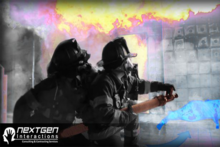NextGen Interactions
FirstSimVR: Measuring Future Tools Using Today's VR
1st place - $20,000 Prize
A reconfigurable VR platform for evaluating and refining future technologies to be used for different first-responder scenarios.

About the Team
Team Members: Jason Jerald, Nat Hoffmeier, Cullen Morris
NextGen Interactions is a consulting and contracting firm that specializes in virtual reality. Founded in 2012, clients and partners consist of a wide range of organizations such as Oculus, AT&T, and Virtuix. Work includes company advising, feasibility reports, customized workshops, and system/application development. Most recently, NextGen Interactions, in partnership with Sixense, HTC, and Digital ArtForms, helped to create and release MakeVR, an award-winning modeling application where content created within VR can be transformed to the real world via 3D printing. Other current projects include a dinosaur excavation game, a VR Arcade experience, and study of new methods to reduce motion sickness.
Jason Jerald is Co-Founder and Principal Consultant at NextGen Interactions, is Adjunct Faculty at Duke University, serves on multiple advisory boards of companies focusing on VR technologies, and speaks about VR at various events throughout the world. Jason has been creating VR systems and applications for over 20 years. He has been involved in over 60 VR-related projects across more than 30 organizations including Valve, Oculus, Virtuix, Sixense, NASA, General Motors, Raytheon, Lockheed Martin, three U.S. national laboratories, and five universities. Jason's work has been featured on ABC's Shark Tank, on the Discovery Channel, in the New York Times, and on the cover of the MIT Press Journal Presence. He has held various technical and leadership positions, and has served on the ACM SIGGRAPH, IEEE Virtual Reality, and IEEE 3D User Interface Committees.
Jason earned a Masters and a Doctorate in Computer Science from the University of North Carolina at Chapel Hill with a focus on perception of motion and latency in VR. He earned a Bachelor of Computer Science degree with a specialization in Computer Graphics and Minors in Mathematics and Electrical Engineering from Washington State University. Jason has authored over 20 publications and patents directly related to VR, most notably the best-selling book "The VR Book: Human-Centered Design for Virtual Reality."
The Solution
FirstSimVR is a versatile VR system that can be configured for specific first-responder scenarios in order to prototype, evaluate, and inform improved design of early virtual and physical prototypes. The FirstSimVR proposal uniquely expanded upon flexible variant scenarios, where the physical space would make use of furniture and obstacles made of low-fidelity materials. This format would be easily reconfigurable to match whatever virtual map was being used. Not only is a physical build and virtual setup described, but the proposal included details on progressing the technology. The FirstSimVR proposal also placed a significant weight on first responder usability, suggesting an iterative approach to creating prototype scenarios with substantial feedback from first responders. Full body modeling was a goal as was using passive haptics as a way to incorporate Project Alloy technology without having to wait for Project Alloy. FirstSimVR was built to cater to the exact scenarios proposed in the Challenge, covering a wide variety of potential experiences and metrics.
Key Features
- Evaluation of six tracked points per user (head, two hands, back, two feet), with other body areas estimated via inverse kinematics.
- Due to dangers of sensory conflict, FirstSimVR would use one-to-one tracking (e.g., not relying on inertial sensors alone that drift over time, or warp space as done with redirected walking or redirected touching) and matching of all sensory stimuli.
- Since FirstSimVR tracks multiple body points, the full body will be represented in the virtual space, rather than the user just being an invisible camera.

